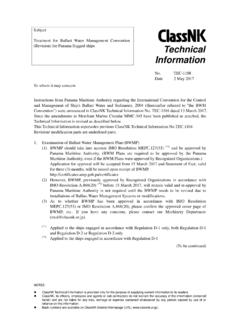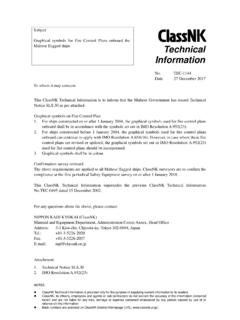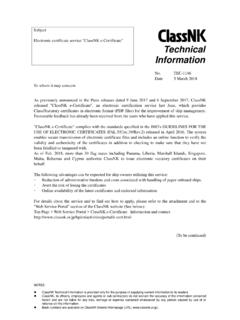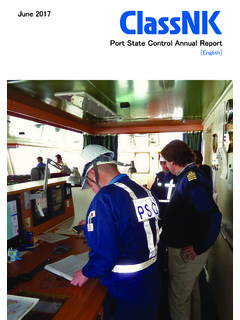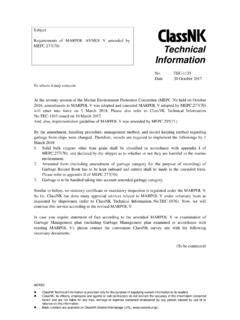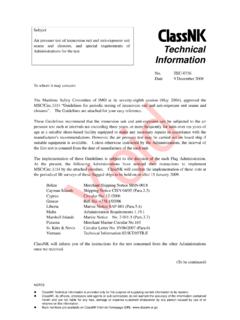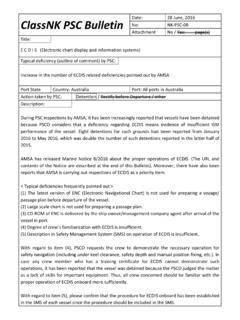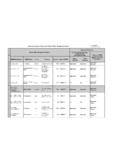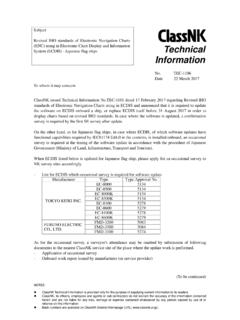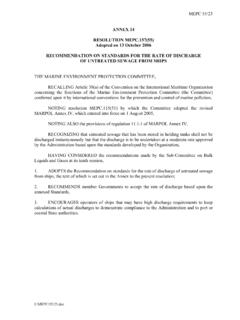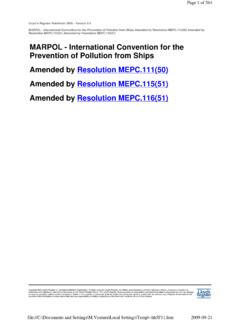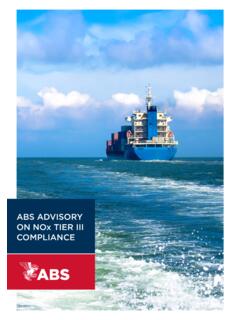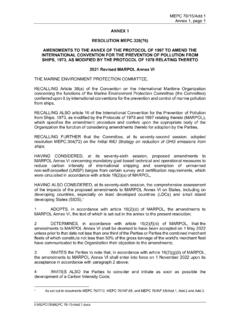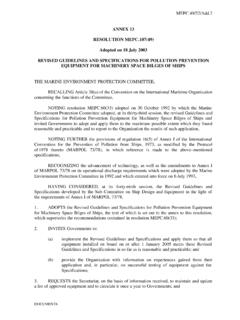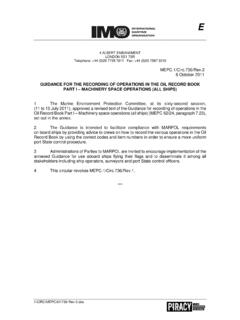Transcription of ANNEX 7 RESOLUTION MEPC.333(76) (adopted on 17 June …
1 mepc 76/15 ANNEX 7, page 1. ANNEX 7. RESOLUTION (76). (adopted on 17 June 2021). 2021 GUIDELINES ON THE METHOD OF CALCULATION OF THE ATTAINED. ENERGY EFFICIENCY EXISTING SHIP INDEX (EEXI). THE MARINE ENVIRONMENT PROTECTION COMMITTEE, RECALLING Article 38(a) of the Convention on the International Maritime Organization concerning the functions of the Marine Environment Protection Committee conferred upon it by international conventions for the prevention and control of marine pollution from ships, NOTING that it adopted, by RESOLUTION (76), the 2021 revised MARPOL ANNEX VI, which is expected to enter into force on 1 November 2022 upon its deemed acceptance on 1 May 2022, NOTING IN PARTICULAR that the 2021 revised MARPOL ANNEX VI contains amendments concerning mandatory goal-based technical and operational measures to reduce carbon intensity of international shipping, NOTING FURTHER that regulation 23 of MARPOL ANNEX VI requires that the attained EEXI. shall be calculated taking into account the guidelines developed by the Organization, RECOGNIZING that the aforementioned amendments to MARPOL ANNEX VI require relevant guidelines for uniform and effective implementation of the regulations and to provide sufficient lead time for industry to prepare, HAVING CONSIDERED, at its seventy-sixth session, draft 2021 Guidelines on the method of calculation of the attained Energy Efficiency Existing Ship Index (EEXI), 1 ADOPTS the 2021 Guidelines on the method of calculation of the attained Energy Efficiency Existing Ship Index (EEXI), as set out in the ANNEX to the present RESOLUTION .
2 2 INVITES Administrations to take the annexed Guidelines into account when developing and enacting national laws which give force to and implement requirements set forth in regulation 23 of MARPOL ANNEX VI;. 3 REQUESTS the Parties to MARPOL ANNEX VI and other Member Governments to bring the annexed Guidelines to the attention of masters, seafarers, shipowners, ship operators and any other interested parties;. 4 AGREES to keep the Guidelines under review in light of experience gained with their implementation and in light of the review of EEXI regulations to be completed by the Organization by 1 January 2026 as identified in regulation of MARPOL ANNEX VI. I:\ mepc \76\ mepc mepc 76/15 ANNEX 7, page 2. ANNEX . 2021 GUIDELINES ON THE METHOD OF CALCULATION OF THE ATTAINED. ENERGY EFFICIENCY EXISTING SHIP INDEX (EEXI). CONTENTS. 1 Definitions 2 Energy Efficiency Existing Ship Index (EEXI). EEXI formula Parameters PME(i) ; Power of main engines PAE(i) ; Power of auxiliary engines Vref ; Ship speed SFC ; Certified specific fuel consumption CF ; Conversion factor between fuel consumption and CO2 emission Correction factor for ro-ro cargo and ro-ro passenger ships (fjRoRo).
3 Correction factor for ro-ro cargo ships (vehicle carrier) (fcVEHICLE). APPENDIX Parameters to calculate Vref,app I:\ mepc \76\ mepc mepc 76/15 ANNEX 7, page 3. 1 Definitions MARPOL means the International Convention for the Prevention of Pollution from Ships, 1973, as modified by the Protocols of 1978 and 1997 relating thereto, as amended. For the purpose of these Guidelines, the definitions in MARPOL ANNEX VI, as amended, apply. 2 Energy Efficiency Existing Ship Index (EEXI). EEXI formula The attained Energy Efficiency Existing Ship Index (EEXI) is a measure of ship's energy efficiency (g/t*nm) and calculated by the following formula: n nME n nPTI neff neff .. fj PME (i ) CFME (i ) SFCME (i ) + (PAE CFAE SFCAE ) + fj PPTI (i ) feff (i ) PAEeff (i ) CFAE SFCAE feff (i ) Peff (i ) CFME SFCME . i =1 j =1 . j =1 i =1 i =1 i =1 . fi fc fl Capacity fw Vref fm * If part of the Normal Maximum Sea Load is provided by shaft generators, SFCME and CFME may for that part of the power be used instead of SFCAE and CFAE.
4 ** In case of PPTI(i) > 0, the average weighted value of (SFCME CFME) and (SFCAE CFAE). to be used for calculation of Peff Note: This formula may not be applicable to a ship having diesel-electric propulsion, turbine propulsion or hybrid propulsion system, except for cruise passenger ships and LNG carriers. Ships falling into the scope of EEDI requirement can use their attained EEDI calculated in accordance with the 2018 Guidelines on the method of calculation of the attained EEDI for new ships ( RESOLUTION (73), as amended, the "EEDI Calculation Guidelines". hereafter) as the attained EEXI if the value of the attained EEDI is equal to or less than that of the required EEXI. Parameters For calculation of the attained EEXI by the formula in paragraph , parameters under the EEDI Calculation Guidelines apply, unless expressly provided otherwise. In referring to the aforementioned guidelines, the terminology "EEDI" should be read as "EEXI". PME(i) ; Power of main engines In cases where overridable Shaft / Engine Power Limitation is installed in accordance with the 2021 Guidelines on the shaft / engine power limit to comply with the EEXI requirements and use of a power reserve ( RESOLUTION (76)), PME(i) is 83% of the limited installed power (MCRlim) or 75% of the original installed power (MCR), whichever is lower, for each main engine (i).
5 In cases where the overridable Shaft / Engine Power Limitation and shaft generator(s) are installed, in referring to paragraph (option 1) of the EEDI Calculation Guidelines, "MCRME" should be read as "MCRlim". For LNG carriers having steam turbine or diesel electric propulsion, PME(i) is 83% of the limited installed power (MCRlim, MPPlim), divided by the electrical efficiency in case of diesel electric propulsion system, for each main engine (i). For LNG carriers, the power from combustion of I:\ mepc \76\ mepc mepc 76/15 ANNEX 7, page 4. the excessive natural boil-off gas in the engines or boilers to avoid releasing to the atmosphere or unnecessary thermal oxidation should be deducted from PME(i) with the approval of the verifier. PAE(i) ; Power of auxiliary engines PAE(i) is calculated in accordance with paragraph of the EEDI Calculation Guidelines. For ships where power of auxiliary engines (PAE) value calculated by paragraphs to of the EEDI Calculation Guidelines is significantly different from the total power used at normal seagoing, in cases of passenger ships, the PAE value should be estimated by the consumed electric power (excluding propulsion) in conditions when the ship is engaged in a voyage at reference speed (Vref) as given in the electric power table, divided by the average efficiency of the generator(s) weighted by power (see appendix 2 of the EEDI Calculation Guidelines).
6 In cases where the electric power table is not available, the PAE value may be approximated either by: .1 annual average figure of PAE at sea from onboard monitoring obtained prior to the EEXI certification;..2 for cruise passenger ships, approximated value of power of auxiliary engines (PAE,app), as defined below: , = + [kW]..3 for ro-ro passenger ships, approximated value of power of auxiliary engines (PAE,app), as defined below: , = [kW]. Vref ; Ship speed For ships falling into the scope of the EEDI requirement, the ship speed Vref should be obtained from an approved speed-power curve as defined in the 2014 Guidelines on survey and certification of the Energy Efficiency Design Index (EEDI), as amended ( RESOLUTION (67), as amended). For ships not falling into the scope of the EEDI requirement, the ship speed Vref should be obtained from an estimated speed-power curve as defined in the 2021 Guidelines on survey and certification of the attained EEXI ( RESOLUTION (76)). For ships not falling into the scope of the EEDI requirement but whose sea trial results, which may have been calibrated by the tank test, under the EEDI draught and the sea condition as specified in paragraph of the EEDI Calculation Guidelines are included in the sea trial report, the ship speed Vref may be obtained from the sea trial report: 1.
7 3. = , [knot]. , . I:\ mepc \76\ mepc mepc 76/15 ANNEX 7, page 5. where, VS,EEDI, is the sea trial service speed under the EEDI draught; and PS,EEDI is power of the main engine corresponding to VS,EEDI. For containerships, bulk carriers or tankers not falling into the scope of the EEDI. requirement but whose sea trial results, which may have been calibrated by the tank test, under the design load draught and sea condition as specified in paragraph of the EEDI. Calculation Guidelines are included in the sea trial report, the ship speed Vref may be obtained from the sea trial report: 2 1. 1 , 9 3. = 3 , [knot]. , . where, VS,service is the sea trial service speed under the design load draught;. DWTS,service is the deadweight under the design load draught;. PS,service is the power of the main engine corresponding to VS,service;. k is the scale coefficient, which should be: .1 for containerships with 120,000 DWT or less;..2 for containerships with more than 120,000 DWT;..3 for bulk carrier with 200,000 DWT or less.
8 4 for bulk carrier with more than 200,000 DWT;..5 for tanker with 100,000 DWT or less; and .6 for tanker with more than 100,000 DWT. In cases where the speed-power curve is not available or the sea trial report does not contain the EEDI or design load draught condition, the ship speed Vref can be approximated by Vref,app to be obtained from statistical mean of distribution of ship speed and engine power, as defined below: 1. 3. , = ( , ) [knot].. For LNG carriers having diesel electric propulsion system and cruise passenger ship having non-conventional propulsion, 1. 3. , = ( , ) [knot].. I:\ mepc \76\ mepc mepc 76/15 ANNEX 7, page 6. where, Vref,avg is a statistical mean of distribution of ship speed in given ship type and ship size, to be calculated as follows: , = . where A, B and C are the parameters given in the appendix;. mV is a performance margin of a ship, which should be 5% of Vref,avg or one knot, whichever is lower; and MCRavg is a statistical mean of distribution of MCRs for main engines and MPPavg is a statistical mean of distribution of MPPs for motors in given ship type and ship size, to be calculated as follows: =.
9 Where D, E and F are the parameters given in the appendix;. In cases where the overridable Shaft / Engine Power Limitation is installed, the ship speed Vref approximated by Vref,app should be calculated as follows: 1. 3. , = ( , ) [knot].. For LNG carriers having diesel electric propulsion system and cruise passenger ship having non-conventional propulsion, the ship speed Vref approximated by Vref,app should be calculated as follows: 1. 3. , = , .. Notwithstanding the above, in cases where the energy saving device * is installed, the effect of the device may be reflected in the ship speed Vref with the approval of the verifier, based on the following methods in accordance with defined quality and technical standards: .1 sea trials after installation of the device; and/or .2 dedicated model tests; and/or .3 numerical calculations. *. Devices that shift the power curve, which results in the change of PP and Vref, as specified in on 2013 Guidance on treatment of innovative energy efficiency technologies for calculation and verification of the attained EEDI.
10 I:\ mepc \76\ mepc mepc 76/15 ANNEX 7, page 7. SFC; Certified specific fuel consumption In cases where overridable Shaft / Engine Power Limitation is installed, the SFC corresponding to the PME should be interpolated by using SFCs listed in an applicable test report included in an approved NOX Technical File of the main engine as defined in paragraph of the NOX. Technical Code. Notwithstanding the above, the SFC specified by the manufacturer or confirmed by the verifier may be used. For those engines which do not have a test report included in the NOX Technical File and which do not have the SFC specified by the manufacturer or confirmed by the verifier, the SFC can be approximated by SFCapp defined as follows: , = 190 [ ]. , = 215 [ ]. CF ; Conversion factor between fuel consumption and CO2 emission For those engines which do not have a test report included in the NOX Technical File and which do not have the SFC specified by the manufacturer, the CF corresponding to SFCapp should be defined as follows: = [ 2 / ] for diesel ships (incl.)
